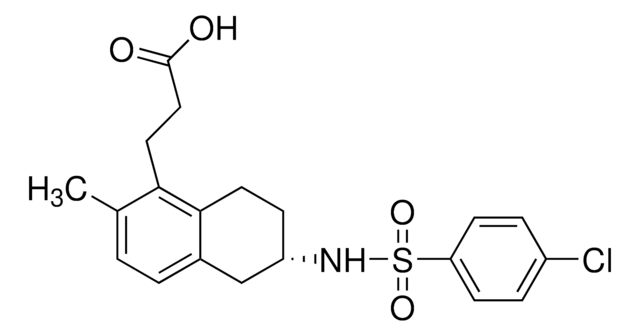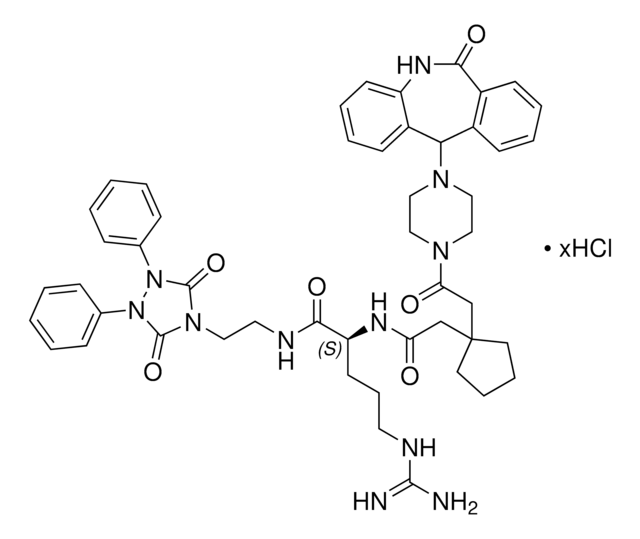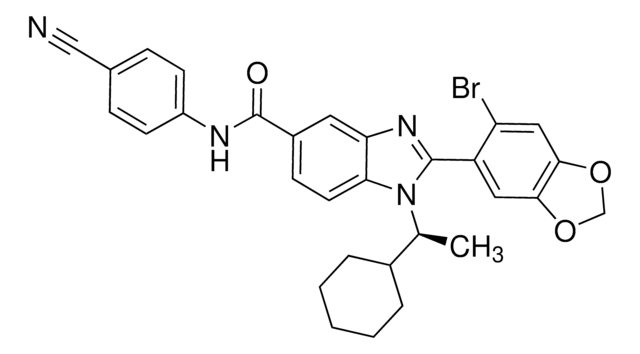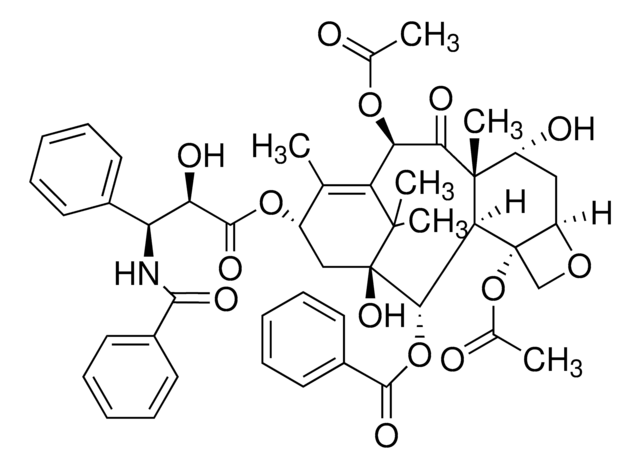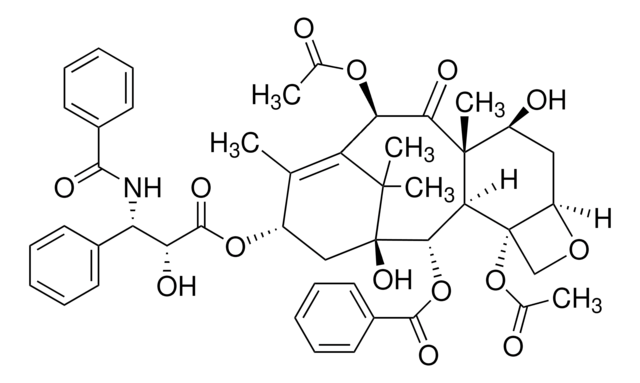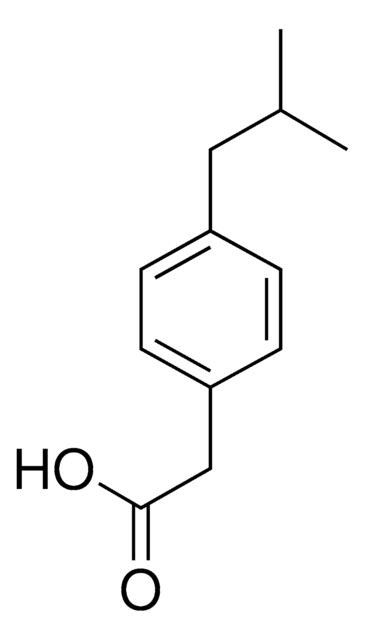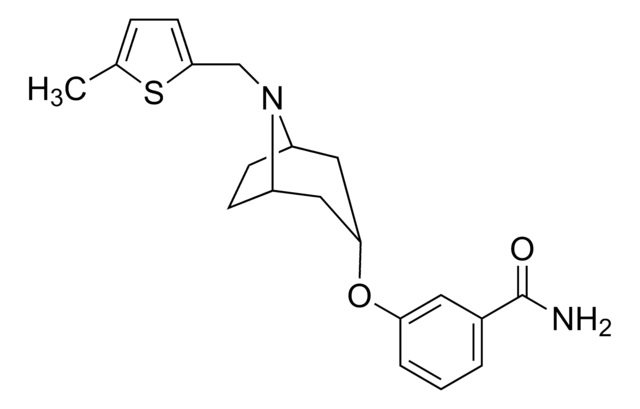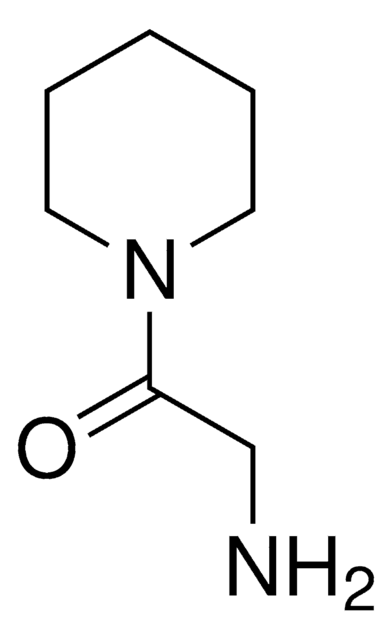SML2452
LY2444296
≥98% (HPLC)
别名:
(S)-3-Fluoro-4-(4-((2-(3-fluorophenyl)pyrrolidin-1-yl)methyl)phenoxy)benzamide, 3-Fluoro-4-[4-[[(2S)-2-(3-fluorophenyl)-1-pyrrolidinyl]methyl]phenoxy]benzamide, 4-[4-[[(2S)-2-(3-Fluorophenyl)-1-pyrrolidinyl]methyl]phenoxy]-3-fluorobenzamide, FP3FBZ, LY 2444296, LY-2444296
登录查看公司和协议定价
所有图片(1)
About This Item
推荐产品
方案
≥98% (HPLC)
表单
powder
颜色
white to beige
溶解性
DMSO: 2 mg/mL, clear
储存温度
2-8°C
SMILES字符串
NC(C1=CC=C(OC2=CC=C(CN3CCC[C@H]3C4=CC=CC(F)=C4)C=C2)C(F)=C1)=O
InChI
1S/C24H22F2N2O2/c25-19-4-1-3-17(13-19)22-5-2-12-28(22)15-16-6-9-20(10-7-16)30-23-11-8-18(24(27)29)14-21(23)26/h1,3-4,6-11,13-14,22H,2,5,12,15H2,(H2,27,29)/t22-/m0/s1
InChI key
WHHMECUDUQRPJT-QFIPXVFZSA-N
生化/生理作用
LY2444296 is a brain-penetrant, orally active, short-acting, high-affinity, potent and selective κ (kappa) opioid receptor (KOR) antagonist (human κ/μ/δ Ki = 0.565/35.8/211 nM against diprenorphine binding; GTP-γ-S binding IC50/agonist/subtype transfectant = 1.57 nM/300 nM U69593/κ, 21.3 nM/1 μM DAMGO/μ 293 nM/30 nM DPDPE/d). LY2444296 reverses κ agonist antinociceptive efficacy in vivo (ED50 = 0.24 mg/kg p.o. against 1 mg/kg U69593 sc. by rat formalin test), decreases immobility time (10 or 30 mg/kg sc.) and prevents enhanced alcohol consumption (5 mg/kg i.p.) among mice subjected to stress by forced swimming.
储存分类代码
11 - Combustible Solids
WGK
WGK 3
闪点(°F)
Not applicable
闪点(°C)
Not applicable
法规信息
新产品
从最新的版本中选择一种:
Charles H Mitch et al.
Journal of medicinal chemistry, 54(23), 8000-8012 (2011-10-01)
Arylphenylpyrrolidinylmethylphenoxybenzamides were found to have high affinity and selectivity for κ opioid receptors. On the basis of receptor binding assays in Chinese hamster ovary (CHO) cells expressing cloned human opioid receptors, (S)-3-fluoro-4-(4-((2-(3-fluorophenyl)pyrrolidin-1-yl)methyl)phenoxy)benzamide (25) had a K(i) = 0.565 nM for
Brian Reed et al.
Neuropsychopharmacology : official publication of the American College of Neuropsychopharmacology, 43(4), 739-750 (2017-09-01)
The κ-opioid receptor (KOP-r) system and its endogenous ligands, the dynorphins, are involved in the neurobiological regulation of addictive states, and of mood. There are limited data on the impact of selective KOP-r antagonism in humans on basic biobehavioral functions
Rachel I Anderson et al.
Frontiers in cellular neuroscience, 10, 45-45 (2016-03-05)
Our laboratory has previously demonstrated that daily forced swim stress (FSS) prior to ethanol drinking sessions facilitates enhanced ethanol consumption in mice with a history of chronic intermittent ethanol (CIE) vapor exposure without altering ethanol intake in air-exposed controls. Because
Peng Huang et al.
Neuroscience letters, 615, 15-20 (2016-01-19)
Prototypical long-acting kappa opioid receptor (KOPR) antagonists [e.g., norbinaltorphimine (norBNI)] have been reported to exert anxiolytic-like effects in several commonly used anxiety tests in rodents including the novelty-induced hypophagia (NIH) and elevated plus maze (EPM) tests. It remains unknown if
Marta Valenza et al.
Psychopharmacology, 234(15), 2219-2231 (2017-05-28)
The recruitment of the stress circuitry contributes to a shift from positive to negative reinforcement mechanisms sustaining long-term cocaine addiction. The kappa opioid receptor (KOPr) signaling is upregulated by stress and chronic cocaine exposure. While KOPr agonists induce anhedonia and
我们的科学家团队拥有各种研究领域经验,包括生命科学、材料科学、化学合成、色谱、分析及许多其他领域.
联系技术服务部门